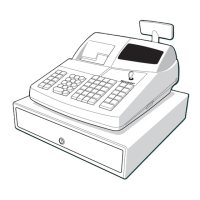
Do you have a question about the Sharp XE-A40S and is the answer not in the manual?
| Type | Electronic Cash Register |
|---|---|
| Departments | 99 |
| PLUs | 2000 |
| Paper Width | 58mm |
| Printer | Thermal printer |
| Operating Temperature | 0°C - 40°C |
Important safety note regarding register initialization.
Key precautions for operating and handling the cash register.
Advice on initial battery charging for memory protection.
Identifies and illustrates the physical components of the cash register.
Explains the function and settings of the mode switch and keys.
Provides the keyboard layout and explains the function of each key.
Describes the operator and customer displays and their indicators.
Step-by-step guide to perform the initial setup and data saving.
Procedure for correctly installing receipt and journal paper rolls.
Essential programming steps before starting sales registration.
Introduces the three main programming sections for tailoring the register.
Covers essential programming like date, time, and tax calculation.
Details programming for convenient use of various keys and functions.
Explains advanced features like register numbers, function selections, and text programming.
Outlines daily operations before, during, and after sales entries.
Demonstrates a typical cash sale transaction process.
Covers methods for entering single items, PLUs, and subdepartments.
Covers methods for completing transactions with cash, check, or credit.
Covers automatic, manual tax entry, and tax deletion methods.
Describes discount and premium entries using percent or discount keys.
Covers currency conversion and how to handle foreign currency payments.
How to void the most recent incorrect entry made during a transaction.
How to void entries made earlier in the current transaction.
Procedure to void an entire transaction before finalization.
How to classify merchandise into departments and set their attributes.
Setting up PLUs and subdepartments for quick price recall and classification.
Customizing the behavior of various function keys for convenience.
Setting unique register numbers and managing consecutive transaction counts.
Selecting various functions for miscellaneous keys, print formats, and tax.
Configuring power save, printer density, language, and training mode.
How to read and print stored programming data from the register's memory.
Example of a programming report showing various settings and parameters.
Example report for AUTO key programming sequences.
Example report for PLU programming data.
Comprehensive daily sales report including totals and tax information.
Report detailing sales totals categorized by department.
Report showing sales performance for individual clerks.
How the register behaves and recovers after a power interruption.
Troubleshooting steps for common printer errors like paper jams or head up.
Step-by-step instructions for installing new paper rolls.
Instructions for cleaning the printer's thermal print head.